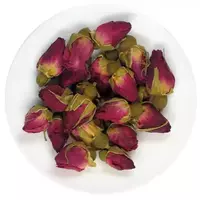Rosebud

It is no secret that the rose is called the "queen of flowers. " This name was given to roses due to their perfect beauty, as well as the beautiful aromas that the flower exudes. It is worth noting that roses are the collective or folk name of some cultivated species of the plant assigned to the genus Rosehip.
The vast majority of rose varieties known to humans were obtained during a long period of breeding and crossing of various species of the plant. Nowadays, only a few pink varieties belong to wild plants. The Russian-language name of the rose flower was borrowed from the Latin language. The official or written history of flowers began in ancient Rome.
Some noble Romans made world history because of their magnificent gardens, in which various varieties of roses grew. Researchers found a large number of references to roses in written documents of the Ancient World. It can be concluded that already in those days roses were considered incredibly valuable and quite expensive flowers.
There is a great variety of different varieties of roses, which differ from each other not only in their appearance, but also in their distribution range. Roses are used not only as an ornamental plant, but also as raw materials for the food, cosmetics and perfume industries. Petals are used in cooking, as well as rose buds.
Rose bud species
Undiscovered small buds of roses are used in the process of preparing sweets, as well as confectionery. In addition, some types of rose buds are used as a natural flavor in the preparation of various drinks, including tea. All types of rose buds contain in their chemical composition a significant amount of valuable essential oil, which has found wide application in the cosmetic and perfume industries.
Oil obtained in the process of processing rose buds is widely used in aromatherapy. Rose buds can be brewed with boiling water and have an aromatic infusion that will be distinguished by its subtle and refined floral aroma, as well as taste. Often, rose buds are added to black and red teas as a natural flavor. It is worth noting that rose buds give the finished drink a warm honey taste.
Real connoisseurs and foodies will always recognize the tea drink, which contains rose buds in a light smoky shade, as well as a subtle aftertaste. In addition to cooking, rose buds are used in folk medicine. Infusions and decoctions prepared from buds of various varieties of roses have pronounced medicinal properties.
Eating rose buds regularly helps strengthen the immune system, as well as enhance the antiviral protection of the human body. In addition, rose buds contribute to the strengthening of the endocrine system, as well as have a painkiller, calming, and in addition have a general strengthening effect on the human body.
rose buds 0.1 kCal
Energy value of rose buds (Ratio of proteins, fats, carbohydrates - ju):
Proteins: 0 g (~ 0 kCal)
Fats: 0 g (~ 0 kCal)
Carbohydrates: 0 g (~ 0 kCal)
Energy ratio (b | y): 0% | 0% | 0%
 Español
Español Français
Français Português
Português Русский
Русский 简体中文
简体中文 繁體中文
繁體中文 日本語
日本語 한국어
한국어 العربية
العربية Türkçe
Türkçe Қазақ
Қазақ Deutsch
Deutsch Italiano
Italiano Українська
Українська
